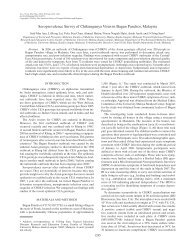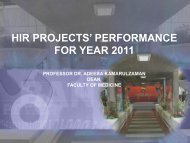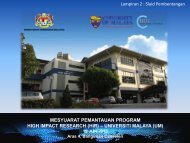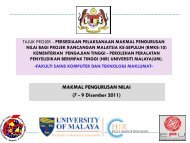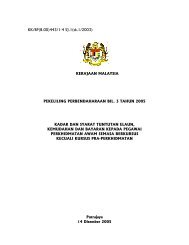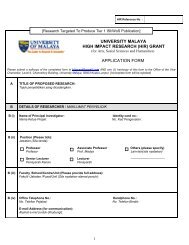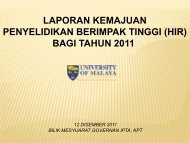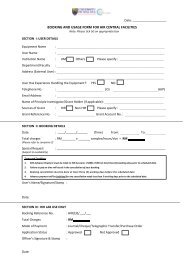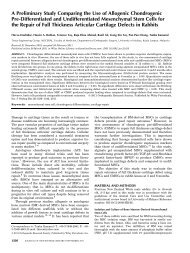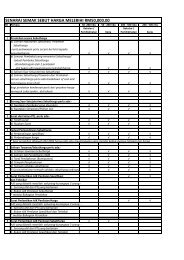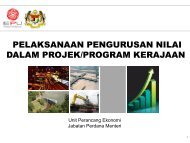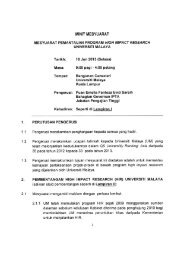Liang Xin Tay, Raja Elina Ahmad, Havva Dashtdar - High Impact ...
Liang Xin Tay, Raja Elina Ahmad, Havva Dashtdar - High Impact ...
Liang Xin Tay, Raja Elina Ahmad, Havva Dashtdar - High Impact ...
Create successful ePaper yourself
Turn your PDF publications into a flip-book with our unique Google optimized e-Paper software.
4 <strong>Tay</strong> et al The American Journal of Sports Medicine<br />
evaluation, all specimens were examined under direct light<br />
microscopy by 2 independent observers, both experienced<br />
orthopaedic surgeons, who were blinded to the sample<br />
groups. The observers were asked to examine and grade<br />
samples according to the Brittberg scoring system. 13 Upon<br />
completion of the scoring, the specimens were halved using<br />
a mechanical bone saw (Fein MultiMaster Accu, C & E Fein<br />
Gmbh, Stuttgart, Germany). This was done carefully to<br />
avoid any alteration or destruction of the tissue specimen<br />
according to the technique previously established by<br />
Kamarul et al. 29,30 Half of each specimen was fixed in<br />
10% phosphate-buffered formalin (4% formaldehyde) for<br />
histology and immunostaining, while the other half was utilized<br />
for analysis of the glycosaminoglycan (GAG) content.<br />
Histologic Examination and<br />
Immunohistochemical Staining<br />
Specimens that were fixed in 4% buffered formalin were<br />
decalcified. Fixed and decalcified tissues were subsequently<br />
dehydrated in ethanol in a stepwise manner from 70% up to<br />
100%, transferred to xylene, and embedded in paraffin. At<br />
the center of each sample, 5-mm paraffin sections were prepared<br />
and placed on glass slides, dried overnight, and stored<br />
at 4°C. The samples were stained with hematoxylin and<br />
eosin for general morphologic evaluation and safranin<br />
O–fast green to detect proteoglycan. Immunohistochemical<br />
staining was performed using DAKO EnVision 1 System<br />
peroxidase kit (DAKO, Glostrup, Denmark). The specimen<br />
section slides were incubated in primary antibody solution<br />
(anti–collagen type II, Santa Cruz Biotechnology, Santa<br />
Cruz, California) followed by secondary antibody and<br />
substrate-chromogen solution in accordance with the manufacturer’s<br />
instructions. The O’Driscoll cartilage scoring was<br />
used for histologic and histochemical assessment of the<br />
repaired cartilage specimens. The scoring was performed<br />
by 2 histologists blinded to the group status.<br />
Biochemical Assay for GAG<br />
The Blyscan GAG assay kit (Biocolor Ltd, Antrim, United<br />
Kingdom) was used to evaluate GAG content of the regenerated<br />
cartilage tissues in both treatment groups. Specimens<br />
were dissected into small pieces using a scalpel and<br />
digested using RIPA buffer (Merck & Co, Whitehouse Station,<br />
New Jersey) supplemented with protease inhibitors<br />
(Sigma) for 1 hour. Aliquots of each sample were mixed<br />
with DMMB (dimethylmethylene blue) dye and reagents<br />
(Biocolor) according to the manufacturer’s instructions.<br />
The absorbance at 656 nm was measured using the spectrophotometer<br />
and compared with a standard plot of chondroitin<br />
sulphate provided by the manufacturer for<br />
quantitative determination of the GAG content.<br />
Statistical Analysis<br />
Statistical analysis was performed using SPSS statistical<br />
software (version 17.0, SPSS Inc, an IBM company, Chicago,<br />
Illinois). The values of Brittberg and O’Driscoll scores,<br />
as well as GAG concentrations for all tissue samples, were<br />
presented as mean 6 standard deviation. Comparisons of<br />
variables between the 2 treatment groups were analyzed<br />
using the parametric 2-sided independent t test. Differences<br />
were considered statistically significant at P \ .05.<br />
RESULTS<br />
Gross Appearance of Defect<br />
Figure 1 illustrates an example of the gross macroscopic<br />
analysis of the representative tissues from the alloMSC,<br />
autoC, and control groups. Macroscopic examinations at<br />
6 months after implantation revealed that defects treated<br />
with both alloMSCs and autoC showed good filling, with<br />
the surface appearing flush and smooth (Figures 1D and<br />
1E). In contrast, none of the untreated defects in the left<br />
knees (control) (Figure 1F) showed complete filling as compared<br />
with the treated knees.<br />
Figure 2 shows the results of Brittberg scores reflecting<br />
quantitative macroscopic evaluation of the tissue regenerate<br />
quality between the alloMSC and autoC treatment groups<br />
together with their respective controls. Both the alloMSC<br />
and autoC implantations showed superior cartilage regeneration<br />
quality as compared with the untreated left knees, as<br />
evidenced by the significantly higher Brittberg scores in the<br />
treatment groups (8.8 6 0.8 vs 3.0 6 0.8 for the alloMSCcontrol<br />
pair, and 6.6 6 0.8 vs 2.3 6 0.6 for the autoC-control<br />
pair; both pairs were associated with a P value of .001). The<br />
difference in Brittberg scores between alloMSC and autoC<br />
was significant (P = .04) from the 2-sided independent<br />
t test. No significant differences in the Brittberg scores<br />
were found between the untreated left knees (control) in<br />
both alloMSC and autoC groups (P =.31).<br />
Histologic and Immunohistochemical Appearance<br />
of the Regenerated Cartilage Tissues<br />
Figure 3 shows the results of the microscopic examination<br />
of the regenerate tissues in 4 groups (ie, the alloMSC-treated<br />
group, the autoC-treated group, the untreated group<br />
[negative control] and a representative specimen of a normal<br />
NZW rabbit’s knee articular cartilage tissue [positive<br />
control]). The microscopic appearance of the tissue using<br />
various staining methods revealed cartilage regeneration<br />
within the treated sites although some areas appeared to<br />
be infiltrated by a small amount of fibrous tissues. In contrast,<br />
the untreated defects did not appear to undergo complete<br />
healing, but were merely filled with soft tissue<br />
instead (Figures 3C, 3G, and 3K). In the hematoxylin<br />
and eosin–stained sections, cartilage from the alloMSCtreated<br />
group (Figure 3A) showed substantial thickening<br />
of the cartilage tissue compared with the untreated defect<br />
(Figure 3C), with the chondrocytes arranged in clusters.<br />
Similar cartilage tissue thickening was also observed in<br />
the autoC-treated group (Figure 3B); however, the chondrocytes<br />
were mostly found in columnar formations. The<br />
regenerated tissues from both treatment groups showed<br />
a continuous surface with a mixture of hyaline and fibrocartilage.<br />
Immunohistochemical staining for type II



